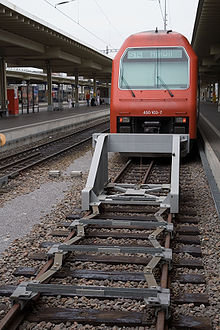Buffer stop

A buffer stop , also known as a buffer weir or buffer, is a form of track closure . It prevents in a dead-end track of a railway vehicle can also roll over the end of the track.
Construction
Buffer stops are usually designed in such a way that they can absorb as much energy from the rolling train as possible in the event of an impact, so that the train remains undamaged if possible. The buffer stop can be deformed or destroyed under certain circumstances. In order to perform this task in the best possible way, buffer stops are usually adapted to the coupling system of the railway. Modern buffer stops are also provided with anti-climb protection.
Simple buffer stop
At first, buffer stops were simple constructions that were suitable for stopping individual, very slowly rolling cars. However, it became clear early on that they do not provide effective protection at only slightly higher speeds and masses. After a series of spectacular accidents around the turn of the century, such as the railway accident at Gare Montparnasse in 1895 and the railway accident at Frankfurt Central Station in 1902, modern, energy-absorbing buffer stops were developed.
Buffer stop
A buffer stop is firmly anchored in the ground or on the running rails, in this case usually through rail holes. If starting speeds greater than 5 km / h are to be expected, damping systems based on hydraulics are usually installed to absorb the residual energy.
Brake bumper
Brake buffer blocks can absorb significantly higher energies than all types of fixed buffer blocks. They are usually attached to the running rails and, if necessary, additional rails by means of clamps clamped by screws. The clamps generate a high coefficient of friction and can, for example, brake a train with a mass of 850 tons at seven meters from 15 km / h to a standstill without damaging the vehicles. If higher masses or speeds are to be expected, a brake buffer stop is also equipped with drag bumps. However, these require a concrete slab as the substrate and thus a significantly higher construction cost.
Foldable buffer stop
In order to temporarily secure a track, foldable or retractable bumper blocks are used as an alternative to safety switches with brake baffles or track barriers . These can be found both as a fixed bumper with and without hydraulic damper and as a brake bumper with brake rails running parallel to the running rails. Foldable buffer stops serve to close off the direction tracks in drainage systems in order to prevent groups of wagons from continuing into the switch area after shunting impacts. For example, movable and retractable buffer stops are installed in the marshalling yard in Nuremberg . This means that there is no need for securing with drag shoes.
Improvised track termination

In some branch lines and in side tracks , very primitive constructions are sometimes used. For example, one may consist of two cross-wise in a sleeper pushed wooden sleepers threshold intersection be prepared as a temporary Track closure.

Sand track
Similar to an emergency lane , the train can be slowed down and brought to a stop by a controlled deflection into a sand track . One known application was at Eibenstock train station and Bf on the Eibenstock steep section .
Germany
In Germany , in front of buffer stops on main tracks, the protective stop signal Sh 2 is usually placed in the form of a board, in front of which in side tracks the signal Sh 0 .
In Europe, buffer stops have had to comply with the requirements of the Eurocodes (especially Eurocode 3) since July 1, 2012 . In the area of Deutsche Bahn, the requirements are regulated in the Deutsche Bahn Standard 918.005.
See also
Web links
- Railway technology: the buffer stops
- History of the track terminations. Retrieved on May 31, 2016 (development from mound to various types of buffer stops).
Individual evidence
- ↑ Trelco AG - Railway Technology - Brake and bumper block. Retrieved February 19, 2017 .
- ↑ Railway technology | Mainline | Passenger transport | foldable buffer stop systems | RAWIE. Retrieved February 19, 2017 .
- ^ Jürgen Schönbrodt, Lothar Mattner: Brake buffer blocks between DIN and Eurocode . In: Railway technical review . tape 63 , no. 10 , 2014, ISSN 0013-2845 , p. 26-31 .





